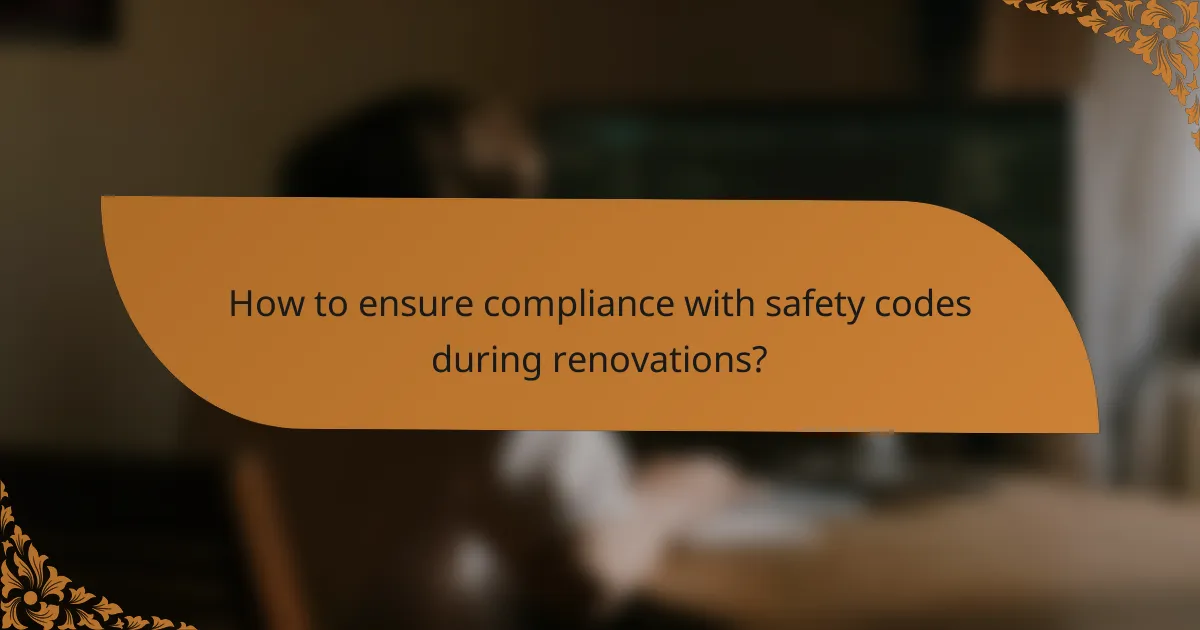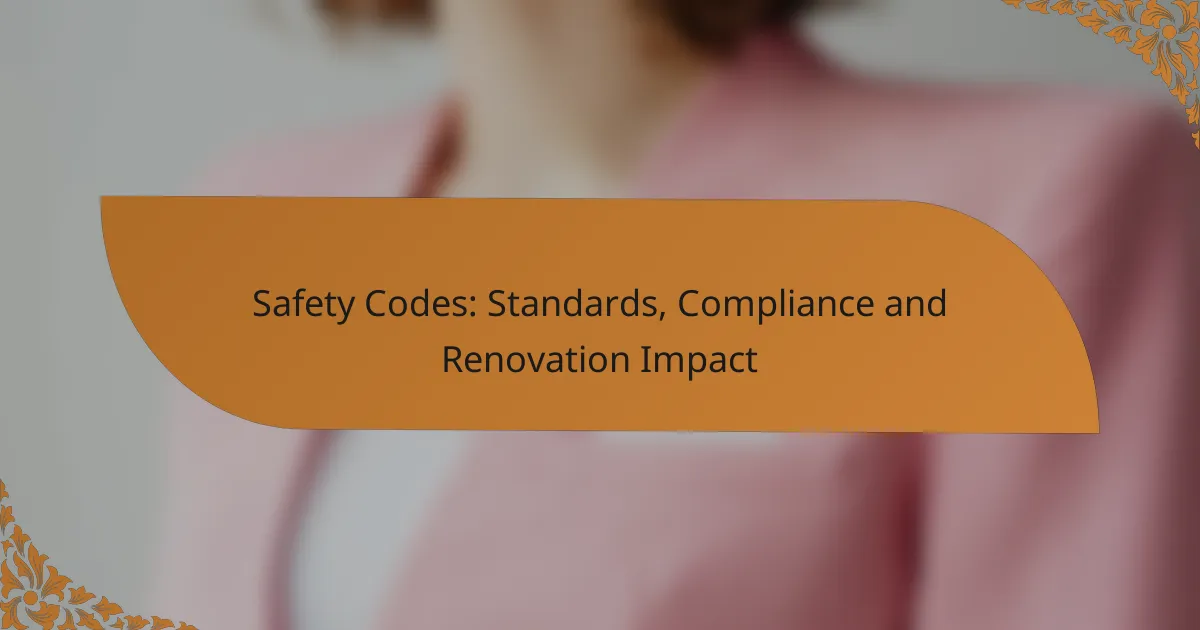Safety codes for building renovations in the United States are essential regulations that ensure structures are safe for occupants and adhere to local, state, and federal standards. These codes encompass various aspects such as structural integrity, electrical systems, and workplace safety, playing a crucial role in protecting public health during renovation projects. Compliance with these codes not only facilitates legal approval but also significantly impacts the renovation process and the overall safety and accessibility of buildings.

What are the safety codes for building renovations in the United States?
Safety codes for building renovations in the United States are regulations that ensure structures are safe for occupants and comply with local, state, and federal standards. These codes cover various aspects, including structural integrity, electrical systems, and workplace safety, and are crucial for protecting public health and welfare during renovation projects.
International Building Code (IBC)
The International Building Code (IBC) sets minimum safety standards for building design and construction across the United States. It addresses structural integrity, fire safety, accessibility, and energy efficiency, ensuring that renovations meet uniform safety criteria.
When planning a renovation, it’s essential to consult the IBC to determine applicable requirements based on the building’s use and occupancy classification. For example, a residential renovation may have different standards compared to a commercial property.
National Electrical Code (NEC)
The National Electrical Code (NEC) governs electrical installations and renovations to ensure safety and functionality. It outlines requirements for wiring, grounding, and circuit protection, which are crucial for preventing electrical hazards.
During renovations, it’s vital to adhere to the NEC to avoid potential fire risks and ensure compliance with local regulations. For instance, upgrading electrical panels or adding new circuits must follow NEC guidelines to ensure safe operation.
Occupational Safety and Health Administration (OSHA) regulations
OSHA regulations focus on workplace safety and health, impacting construction and renovation projects. These regulations require employers to provide a safe working environment, which includes proper training, protective equipment, and hazard communication.
Renovation projects must comply with OSHA standards to protect workers from potential hazards such as falls, electrical shocks, and exposure to harmful substances. Implementing safety protocols and conducting regular safety audits can help mitigate risks on-site.

How do safety codes impact renovation projects?
Safety codes significantly influence renovation projects by establishing the standards that must be met to ensure the safety and well-being of occupants. Compliance with these codes is essential for legal approval and can affect various aspects of the renovation process.
Compliance requirements
Compliance with safety codes involves adhering to local, state, and national regulations that govern construction practices. These requirements can include building permits, inspections, and adherence to specific standards for materials and design. Failure to comply can lead to fines, delays, or even the need to redo work.
It’s crucial to consult local building authorities early in the renovation process to understand the specific codes applicable to your project. This proactive approach can help avoid costly adjustments later on.
Cost implications
Renovation projects must account for costs associated with meeting safety codes, which can vary widely based on the scope of the work and local regulations. Budgeting for permits, inspections, and potential upgrades to meet code standards is essential. In some cases, these costs can represent a significant percentage of the overall renovation budget.
For example, if a renovation requires updated electrical or plumbing systems to comply with current codes, the costs could range from a few hundred to several thousand dollars, depending on the extent of the work needed.
Timeline adjustments
Adhering to safety codes can extend the timeline of renovation projects due to the need for inspections and potential rework. Each phase of the renovation may require approval before proceeding, which can add weeks or even months to the schedule. Planning for these delays is critical to avoid frustration and ensure project completion.
To mitigate timeline impacts, consider scheduling inspections at key milestones and maintaining open communication with contractors and local authorities. This strategy helps to streamline the process and keep the project on track.

What are the key compliance standards for safety codes?
Key compliance standards for safety codes ensure that buildings are safe, accessible, and meet specific regulations. These standards vary by location but generally include local building codes, fire safety regulations, and accessibility requirements under the Americans with Disabilities Act (ADA).
Local building codes
Local building codes are regulations established by municipalities that dictate the minimum safety standards for construction and renovation. These codes cover structural integrity, electrical systems, plumbing, and energy efficiency, ensuring that buildings are safe for occupants.
When planning a renovation, it’s crucial to consult local building codes to avoid costly fines or mandatory modifications. Each jurisdiction may have unique requirements, so checking with local authorities or a licensed contractor can provide clarity on what is needed.
Fire safety standards
Fire safety standards are designed to prevent fire hazards and ensure safe evacuation in case of an emergency. These standards often include requirements for fire alarms, sprinkler systems, fire-resistant materials, and clear exit pathways.
Compliance with fire safety standards can vary significantly based on the building’s use and occupancy. For instance, commercial buildings typically have stricter regulations than residential properties. Regular inspections and maintenance of fire safety systems are essential to ensure ongoing compliance.
Accessibility standards (ADA)
Accessibility standards under the Americans with Disabilities Act (ADA) mandate that public buildings be accessible to individuals with disabilities. This includes requirements for ramps, door widths, signage, and restroom facilities that accommodate various needs.
When renovating, it’s important to assess existing structures against ADA guidelines to ensure compliance. Non-compliance can lead to legal issues and limit access for people with disabilities, so incorporating these standards from the outset is advisable.

How to ensure compliance with safety codes during renovations?
To ensure compliance with safety codes during renovations, it is essential to follow established guidelines and regulations that govern construction practices. This involves consulting with professionals, conducting thorough inspections, and obtaining the necessary permits to avoid legal issues and ensure safety.
Consulting with licensed contractors
Engaging licensed contractors is crucial for adhering to safety codes during renovations. These professionals are knowledgeable about local regulations and can provide insights on best practices and compliance requirements specific to your project.
When selecting a contractor, verify their credentials and experience in similar renovation projects. This can help prevent costly mistakes and ensure that all work meets safety standards.
Conducting pre-renovation inspections
Pre-renovation inspections are vital for identifying potential safety hazards before work begins. This process typically includes assessing the structural integrity of the building, checking for hazardous materials like asbestos, and evaluating existing electrical and plumbing systems.
Consider hiring a qualified inspector to conduct a comprehensive evaluation. Their findings can guide your renovation plans and help you address any issues that may affect compliance with safety codes.
Obtaining necessary permits
Obtaining the required permits is a fundamental step in ensuring compliance with safety codes during renovations. Most jurisdictions require permits for significant alterations, additions, or changes to a building’s structure or systems.
Check with your local building authority to understand which permits are necessary for your project. Failing to secure the appropriate permits can result in fines, delays, and potential safety hazards.

What are the consequences of non-compliance with safety codes?
Non-compliance with safety codes can lead to significant legal and financial repercussions for individuals and businesses. These consequences often manifest as fines, increased liability, and potential harm to reputation.
Fines and penalties
Fines for non-compliance with safety codes can vary widely depending on the severity of the violation and the jurisdiction. In many cases, penalties can range from hundreds to thousands of dollars, with repeat offenders facing even steeper fines.
In addition to direct fines, businesses may incur costs related to remediation efforts required to bring properties into compliance. This can include hiring specialists or undergoing extensive renovations, which can add up quickly.
Increased liability risks
Failure to adhere to safety codes increases liability risks significantly. If an accident occurs due to non-compliance, affected parties may pursue legal action, leading to costly lawsuits and settlements.
Moreover, businesses may face higher insurance premiums or difficulty obtaining coverage altogether if they have a history of safety violations. This can create long-term financial strain and operational challenges.
